| Columns Retired Columns & Blogs |
"Diamonds" in the sky ............. Rihanna :-) ..........
I used DRA Labs' MLSSA system and a calibrated DPA 4006 microphone to measure the Tidal Akira's frequency response in the farfield, and an Earthworks QTC-40 for the nearfield and spatially averaged room responses. I was neither able to move a speaker as large and heavy as this—each Akira's polished stainless-steel base alone weighs 70 lb—out of the listening room, nor raise it off the floor to measure it. I aimed the speaker across the room's diagonal to push back in time the reflections from the sidewalls, but the reflections of the speaker's output from the floor and the 8' ceiling limit the acoustic measurements' resolution below 1kHz.
My estimate of the Akira's voltage sensitivity was 87.5dB/2.83V/m. The Akira's impedance remains above 8 ohms throughout the midrange and treble, but drops below 6 ohms in the upper bass, with a minimum magnitude of 3.5 ohms at 111Hz (fig.1, solid trace). However, the electrical phase angle (fig.1, dashed trace) doesn't reach extreme values, and the Akira will work with amplifiers that are comfortable with 4 ohm loads.
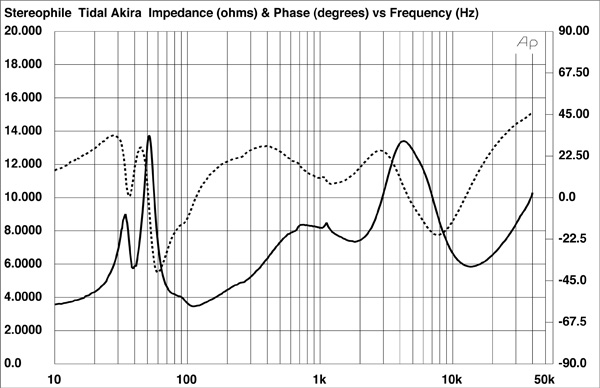
That massive cabinet seemed free from any panel resonances, which is why I haven't included my usual accelerometer-derived cumulative spectral-decay plot. However, the small discontinuities at 90Hz, 700Hz, and 1.1kHz in the traces in fig.1 suggest that something is not quite right at those frequencies. Listening to the enclosure walls with a stethoscope while I played test tones from my Editor's Choice CD revealed nothing amiss at those frequencies, but I was still bothered by the discontinuity at 1.1kHz. I therefore repeated the impedance measurement with the other speaker of the pair. It behaved identically, however.
The saddle centered at 39Hz suggests that the five passive radiators are tuned to this frequency, and the three woofers, measured in the nearfield, all had minimum-motion notches between 39 and 41Hz, as well as a small suckout centered on 90Hz (not shown). They behaved differently at higher frequencies, however. While the bottom woofer rolled off above 120Hz, the upper two woofers maintained their output for crossover to the midrange unit at around 200Hz. The middle woofer is then rolled off more steeply above the crossover region than the top woofer. The passive radiators rolled off rapidly above and below the 30–60Hz region.
The blue trace below 300Hz in fig.2 shows the complex sum of the nearfield drive-unit outputs, taking into account amplitude, acoustic phase, and the fact that the passive radiators are mounted on the speaker's rear, which is 21" behind the front baffle. The integration of the midrange unit's with the woofers' outputs doesn't appear to be as smooth as usual; the usual broad peak in the bass due to the nearfield measurement technique is broken by a lack of energy between 80 and 220Hz.
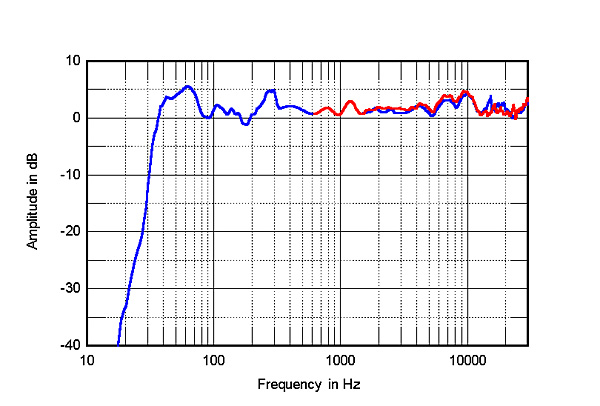
Examined in the nearfield, the midrange unit had a 3dB-high step in its output at 1.1kHz, the frequency of one of the discontinuities in the impedance traces. This results in a small peak at that frequency in the Akira's farfield response, averaged across a 30° horizontal window centered on the tweeter axis (fig.2, blue trace above 300Hz). This peak was identical in the left and right speakers. The two speakers do match closely, though the right speaker (red trace) has slightly more energy present between 2 and 9kHz, with a maximum difference of 0.8dB at 7kHz. The left speaker (blue trace), whose tweeter was replaced after the accident, also has a small peak apparent at 15.3kHz that is absent in the right speaker.
Because I was unable to lift an Akira onto my Outline computer-controlled turntable, I had to assess the speaker's lateral dispersion by positioning the microphone at 5° intervals in an arc centered on the tweeter axis. Because of the proximity of the room's walls, I had to limit the dispersion plot to 45° to the speaker's sides rather than the usual 90°. The result, normalized to the tweeter-axis response (fig.3), reveals that the tweeter starts to become directional above 13kHz. However, the dispersion below the top octave is well controlled and the contour lines are relatively even, this correlating with the precise stereo imaging I heard. In the vertical plane (fig.4, again normalized to the tweeter-axis response), the Akira's response doesn't change appreciably over a relatively wide window. This is a good thing, considering that the tweeter is 45" from the floor, and our research in the 1990s found that 36" is a typical ear height for a seated listener.
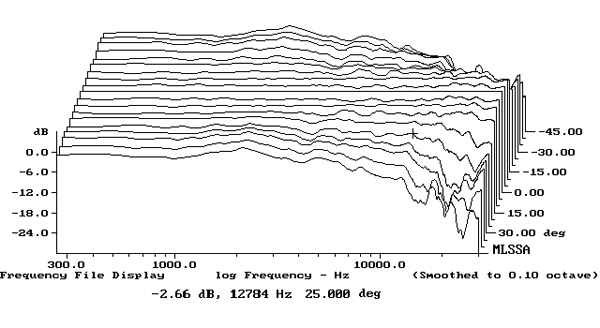
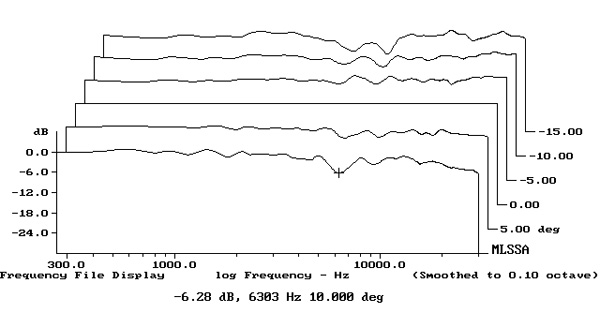
The red trace in fig.5 shows the Akiras' spatially averaged response in my room, generated by averaging 20 1/6-octave–smoothed spectra, taken for the left and right speakers individually using a 96kHz sample rate, in a vertical rectangular grid 36" wide by 18" high and centered on the positions of my ears. For comparison, the blue trace in this graph shows the spatially averaged response of the Wilson Alexia Series 2, which I reviewed in the July 2018 issue, measured in an identical manner and with the speakers in close to the same positions in my room as the Tidals. The two speakers appear to have very similar responses throughout the midrange, but the Tidals have more energy between 1 and 2kHz, the Wilsons more presence-region and top-octave energy. Regarding the latter, the Akiras' behavior is closer to what I've come to hear as being the correct amount of high treble in my room, due to the increasing absorption by the room's furnishings as the frequency rises. (A flat high-treble response is not what you want to see in this kind of measurement.) The Akiras have less upper-bass energy than the Wilsons, and while they excite the lowest-frequency mode in my room to a similar degree, their low-bass output rolls off below the frequency of that room mode, whereas the Wilsons offer a lot more output between 15 and 30Hz.
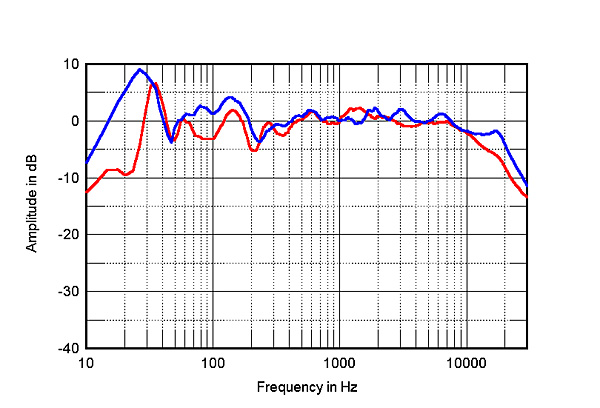
In the time domain, the Akira's step response on the tweeter axis (fig.6) reveals that the tweeter and woofers are connected in negative acoustic polarity, the midrange unit in positive polarity. The tweeter's output arrives at the microphone before that of the midrange, which in turn arrives before that of the woofers. The decay of each unit's step blends smoothly with the start of the step of the next lower in frequency, implying optimal crossover design. Other than a small amount of delayed energy associated with the peaks just above 1kHz and at 15kHz noted earlier, the Tidal's cumulative spectral-decay plot (fig.7) is extraordinarily clean.
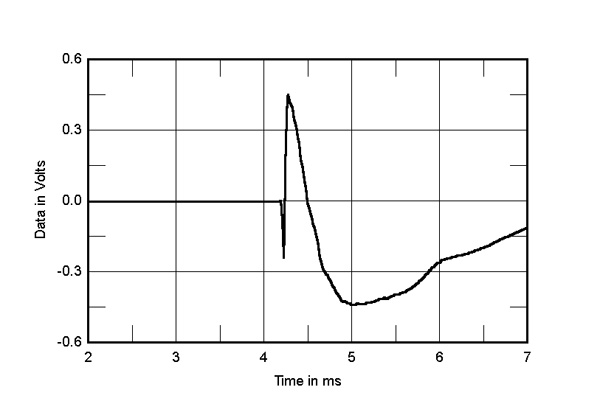
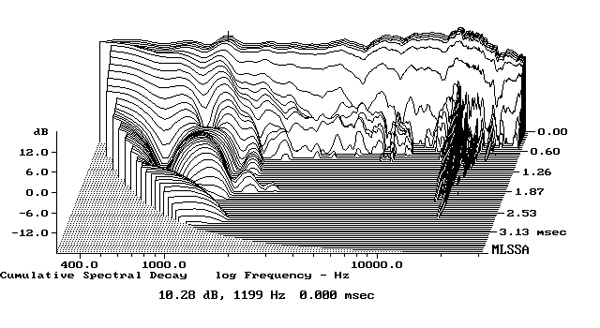
Measuring a speaker as large and bulky as Tidal's Akira is always problematic, but overall it offers generally excellent measured performance. I do wonder, however, if the slight degree of "character" I heard in the upper midrange is associated with the behavior I noted between 1 and 2kHz in the midrange unit's output.—John Atkinson

"Diamonds" in the sky ............. Rihanna :-) ..........

How can the diamonds get fried? ....... Aren't they supposed to be heat resistant? :-) ..........

May be JA could review one of the new Aurender music servers, shown at RMAF 2018 ......... The new servers are available up to 24TB or 12 TB x2 (RAID1) built-in internal storage .............. BTW, the new servers are also, MQA capable (you don't have to use MQA, if you don't want it .... MQA police are not gonna put you in jail) .......... Aurender also showed a unit with a built-in CD ripper along with the new music servers at RMAF 2018 ........... We don't have to mess with the conventional computers ........... There is a pre-view posted on AudioStream website :-) ...........

...Better can be made DIY with DSP and a fully active design for way less money. The kicker with that is you have to know how to design them. I do.
Regardless, Accuton makes a good deal of the best speaker drivers on the planet. And the measurements show this is a great speaker.
Unfortunately, had they gone the active route, done the speaker as a partial dipole, used DSP and made a servo cardioid sub to go with it, this speaker would be even more mind-blowing.
I can make a DIY system using close to the exact drivers from Madisound with Benchmark AHB2 amps to drive the mains and Rythmik servo subs for less than $50K. I think that's on the extremely high side.
I can see from the photos that this is a ridiculously engineered speaker. There were no corners cut. It's state of the PASSIVE art which means it's not state of the art.
I think Tidal is marching in the wrong direction. When they finally make fully active speakers, watch out!

I remember your trenchant posts about Wilson speakers, now the Tidals.
You are missing a real market niche, here!
Can we see the stuff you've made?

I'm planning on a couple (or more) upgrades, and would love to see something on floorstanders as that's one of my near future upgrades. Although my budget is a tad smaller, it would be nice to see something of good quality that would put a fraction of the dent in my pocketbook!
Cheers,
Terry

Have you open-sourced, or posted anything we could learn more about? I think we are entering a new age of DIY with 3D printing, home laser cutters, and DIY CNC machines. I would be greatly interested in your designs. The ability to recreate fully fleshed out and creatively designed edge-of-the-art gear has never been better. Though one might argue it was easier in 1920 when all you needed was a plank of wood a couple of tubes and a transformer. Or in the case of loudspeakers a really big horn and call it done.

How did you sneak those babies past Fremer, he's the high end speaker reviewer.
I love you, JA, but I hope you shipped them to Mike for a definitive opinion.
I loved "wallet straining."
It would be "wallet herniating and mortally disemboweling for me!"
Thanks for a fun read.
I did note that Tidal seems to using the Contribution Pricing model.

Wallet is gonna drag down the balls too along with it, while herniating :-) ................
"Great Balls of Fire" ............. Jerry Lee Lewis :-) ..............

Speaker and electronics company Tidal (pronounced Tee - DAHL) is totally independent of / completely unrelated to music streaming company Tidal.

....... And Alexia is not made by Amazon Alexa and Jeff Bezos :-) ..........

And Wilson Audio is not owned by Wilson Phillips or Woodrow Wilson :-) .............

... the $20K KEF Reference 5 speakers "gave me all I need for musical and sonic satisfaction."
So, what more does the Tidal Akira do for over ten times the price?
https://www.stereophile.com/content/kef-reference-5-loudspeaker-page-2

Comes with "diamonds" .......... You know diamonds are expensive :-) .........

Having the TIdal speakers allows one to glow about them while ferrying friends via private jet for a weekend at the house in Aspen.

Revel top of the line Ultima Salon2 speakers $22,000 (Stereophile Class-A) .......... Have been in continuous production for at least 10 years ......... Stereophile reviewer LG uses them in his reference system ........ JA also did a follow-up review ...........

One of the amplifier models used by LG for the review of Salon2 were Bryston model 28-B mono blocks which put out 1000 watts into 8 Ohms .......... Those amplifiers were also reviewed by Stereophile ........ Those amps are also in continuous production for at least 10 years with some internal parts changes ..........

The Salon2 does not go much below 4 Ohms ......... The Bryston 28-B is capable of delivering up to 1800 watts into 4 Ohm loads .......... The KEF Reference 5 does not go much below 4 Ohms either .......... So, the 28-B can deliver up to 1800 watts to KEF also ............

...more of that "we can't repair vintage computers" thing I described in my review of the Roon Labs Nucleus+ server last August. So I bought myself an i7 Mac mini...
Ouch. The Mini hasn't been updated since October, 2014, so it was vintage even before you strained your wallet. (Okay, PCs aren't that expensive these days, thank God.)
The buyers guide at MacRumors.com is a good resource here.

Your comments about how those of us who could never afford the equipment at these prices still enjoy reading about them.

Wow, was jealous (not of the speakers) they are nice to read about for entertainment (just like my old Scrooge McDuck comics) but of John having caught Yes in concert in their prime and peak years. WOW.
Caught the Rabin, Anderson, Wakeman version of Yes earlier this year and they were excellent. I had not planned to go but caught Roundabout on the radio and decided what the Hell, why not. So glad I went as Anderson sounded incredible. Cannot believe he can still sing so effortlessly and relaxed in that range for close to two hours. Great show. Just flat out fun and enjoyable.
Hope Scrooge McDuck, the Saudi princes, and Russian oligarchs enjoy the speakers.

You could probably hide an entire body inside a pair of those, if it was butchered correctly.

Those partitions in the loudspeakers can perfectly fit those parts :-) ...........

Why bother ?
We might have ROLEX cravings but probably not the $200,000 Presidential in 24k Gold with high quality diamonds. ( or something even pricier like a PP )
We can realistically expect the $20K loudspeakers from PS Audio to be fully competitive or probably better than these Fancy Pancy Tidals that don't have the Arnie Nudel DNA.
Of course, if you are already a Gulfstream Owner being driven around in the backseat of a S600 AMG merc. these beautiful Diamond encrusted cabinets are right down your disposable income stream, after all, you earned it.
Certainly, a Pair for the Hamptons House. ( maybe a full 7.1 surround system, for gods sake )
Tony in Michigan

That Hamptons House deserves Wilson WAMM speakers with Thor's Hammer sub-woofers 7.1 surround sound system :-) ...........

A pair of Raidho D-2.1 speakers have a total of four mid-range/woofer drivers with diamond coatings and retail for $48,000 to $54,000. The Tidal Akira speakers have just two mid-range drivers of diamond and retail for $215,000. The rest of the Raidho D-2.1 also appears to be made with expensive components. I would have appreciated Mr. Atkinson showing greater skepticism for the price in this review.
Let's remember that you can still get a pretty good home for $215,000 in parts of the U.S. (never mind in other parts of the world).
My understanding is that Stereophile's policy is not to review components in its full reviews, as was done here, unless the product has five US dealers or, in some cases, is available by mail order. This review said the number of dealers wasn't disclosed.
I think because of the ridiculous price and the apparent lack of dealers Stereophile should not have reviewed it, at least as a full review.

There wouldn't be a Dealer Network for this sort of thing, would there ?
It's an Inner Circle of Guru's that help the Affluent top 1%ers ( like Sports Stars with 1.5 Mil. Contracts ) fill their Status & Ego needs.
Beryllium drivers are shit compared to Real Diamond Coated drivers.
People that read this Magazine are the people that are "NEVAH" allowed on that other side of the Velvet Rope. FOR GOD'S SAKE!!
We regular civilians live wonderful lives dreaming about owning a Rogue Amp, a Pass Amp, a Prima Luna Amp & maybe a nice selection of interconnect Cabling and if we get lucky a P20 from PS AUDIO!
Magazine Covers are a World of their own, they sit on the Barns & Noble Shelp competing with all the other Glossys for the best reach and grab numbers ( sell-thru ). After-all, didn't we read Playboy for the Journalism ? ( or Rolling Stone for that matter )
This issue : Jim Austin & Nelson Pass, Focal Kanta by Deutsch, Jim Austin and the PS Audio P20, scribbler extraordair talks Rogue, JVS does Tubes ( egads ) must read, HR looks at the PS Sprout mk.2, JA studies Luxman, Iverson looking at D/A conversion.
Phew, tons of dam good stuff with a vintage Aretha Franklin on the Front cover. ( singing for Ortofon )
Stereophile saves me from following the Corn Harvest yields too closely, thank-y'all !
Tony in Michigan

I'm reading a lot of post complaining about the Tidal's pricing, and yes it's up there. However, I remember hearing the Tidal Piano Diacera's in a show years ago - and they're one of the best I've heard in my life! Fit and finish were superb, and the sound almost made me cry and shout at the same time. They were better than the B&W 802's that I heard, Better than Aerial 7t's, better than Martin Logan CLX, and better (imho) than the MBL setup at that show as well. Yes, the speakers cost a lot and I may never have an opportunity to own them (unless I win Megamillons). I haven't heard these yet - but if they take their DNA from the Piano's.....they just might bring a person to tears.

The below quote hints to the forgotten item.
"To pay my own tribute, while lifting to my lips a glass of a rather nice Pinot Grigio"
Come on JA, you can't leave your fellow wine lovers hanging on what this nice Pinot was :)
The cabinet construction picture is impressive indeed but given the fact that the noted "discontinuities at 90Hz, 700Hz, and 1.1kHz" were present in both cabinets its probably safe to assume that this issue wasn't the result of a botched "in field" hardware replacement on the one speaker requiring a fix.
Perhaps "Cork" isn't the right material to be used as a buffer between the drivers and the cabinet in this case. Afterall, for almost a cool quarter mil for these speakers one might expect something a bit more esoteric in terms of materials.

Let's see, JA has mentioned beer in a recent review, now wine.
There was a Scotch fueled review at Audio Stream.
I'm liking the mild added lifestyle joy, thank you!

They need to get some bourbon, tequila, vodka, gin, cognac, hard cider and moonshine fans in the reviewing team :-) ...........

I'll go for one bourbon, one scotch, and one beer while listening to John Lee Hooker.
You can take it from there!

The version of those diamond tweeters available to the public from Thiel and Partner (Accuton) measure so poorly that they are unusable. The uptick in distortion at ~9khz makes them the worst measuring tweeter I have seen.

Dear sirs: did anybody of you had the chance to listen to this speaker? If so, i am pretty shure the comments on this side would be much more favorable. I have been fortunate to compare on many occasions at the High-End shows in Munich what the exposing manufakturers call theyr pinnacle products. Till now, no other design managed to bring me closer to the music.
The Tidal-speakers,- althou admittedly pricey,- are far from the most expensive ones in this context, what makes them an even greater achievment in my opinion. You can hear the money beeing spend for the ingredients not for advertisement. Congratulations from my side to Mr. John Atkinson for his sincere rewiew of the Akiras. Please go and have an ear for yourself. There are much cheaper Tidals out there.
Best regards, K.Müller
( Please excuse my imperfect english )